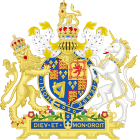| Act of Parliament | |
 | |
| Long title | An Act authorizing certain Commissioners of the realm of England to treat with Commissioners of Scotland, for the weal of both kingdoms. |
|---|---|
| Citation | 1 Jas. 1. c. 2 |
| Dates | |
| Royal assent | 7 July 1604 |
| Commencement | 1604 |
| Repealed | 28 July 1863 |
| Other legislation | |
| Repealed by | Statute Law Revision Act 1863 |
Status: Repealed | |
| Union of England and Scotland Act 1605 | |
|---|---|
| Act of Parliament | |
 | |
| Long title | An Act declaratorie, explayning a branche of an Acte made in the first Session of this Parliament, intituled, "An Acte authorizing certaine Comissioners of the Realme of Englande to treat with Comissioners of Scotlande for the Weale of both Kingdomes." |
| Citation | 3 Jas. 1. c. 3 |
| Dates | |
| Royal assent | 27 May 1606 |
| Other legislation | |
| Repealed by | Statute Law Revision Act 1863 |
Status: Repealed | |
The Union of England and Scotland Act 1603 (1 Jas. 1. c. 2), full title An Act authorizing certain Commissioners of the realm of England to treat with Commissioners of Scotland, for the weal of both kingdoms, was an Act of Parliament of the Parliament of England enacted during the reign of King James I. It appointed a commission led by the Lord Chancellor, Lord Ellesmere, to meet and negotiate with a commission which would be appointed by the Parliament of Scotland. The aim of the discussions was to look into the possibility of arranging a formal political union between England and Scotland, going beyond the existing Union of Crowns, and to report back to Parliament. The commission was not effective, however, and similar subsequent proposals also fell flat. The two kingdoms were eventually united over a century later, by the Acts of Union 1707.
The Act was repealed by the Statute Law Revision Act 1863, being by this point entirely obsolete.
YouTube Encyclopedic
-
1/3Views:2 428 93019 7781 883
-
How Scotland Joined Great Britain
-
The Kingdom of Great Britain
-
The History Hut: The Act of Union Pt. 1
Transcription
Back in the 1690s there were only two countries on the island of Great Britain: The Kingdom of Scotland and the Kingdom of England. England and the other great european powers were doing rather well for themselves by expanding their empires through the cunning use of flags. Scotland had no empire but wanted to join in the game, and thus needed to establish a colony of her very own. But where to build it? "Panama!" declared Scotland. She imagined the colony's strategic location would make trade with the far east safer and faster by eliminating the long journey around the hazardous Cape of Good Hope and Cape Horn where both wind and wave delight in smashing ships against rock and ice. "Who will lend me money to make this great idea a reality?" asked Scotland. No one, was the answer. Instead of helping, the european empires started trade wars with Scotland to limit the power of their future rival. So, poor Scotland had to fund the project herself. She gathered up all the money she could, literally put it all in a big box and, capital thusly raised, sent off a colonial ship. 400,000 pounds, 8,000 kilometers and 111 days later, 2,500 Scotsmen landed on the shores of Panama, named it 'New Caledonia' and immediately discovered a few small problems with their plan: First, the mountains on the western side of Panama were a wee bit larger than expected, making overland trade pretty much impossible. Even if they had thought of building a canal, the technology to do so was still 200 years away. Second, The woolen goods brought to trade with the locals was useless in the endless heat and humidity. Third, the Spanish Conquistadors had already planted flags on the sandy beaches and weren't too happy to see the scots arrive. And fourth, without adequate supplies, disease such as the perennial tropical favorite, Dysentery, spread quickly. Two years and 2,000 dead scots later, they abandoned the project. Now, this wasn't the first failed attempt at Scottish empire -- early colonies had been tried and abandoned in Nova Scotia, New Jersey and Carolina, but the Panama debacle was particularly devastating to Scotland because she was over-invested. Remember that money-in-a-box? Turns out it was a fifth of the wealth of the whole country. Oops. Scotland's sudden impoverishment proved a golden opportunity for The Kingdom of England who was growing increasingly worried that her neighbor to the North would ally with an enemy. England offered Scotland a deal that would reimburse Scotland for her losses if she voted for union. In 1707 Scotland agreed and the Kingdom of Great Britain was born. While the surrender of independence was unpopular in Scotland, her economy improved with access to once English (now British) trade routes and she played a formative role in what would soon be the largest empire in human history. That being said, still more than 300 years later, Scotland has never fully given up her national identity and thoughts of independence.
References
- Select statutes and other constitutional documents illustrative of the reigns of Elizabeth and James I, ed. by G. W. Prothero. Oxford University Press, 1913. Fourth edition.
- Chronological table of the statutes; HMSO, London. 1993
